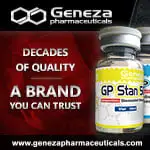jronimoe15
New member
I read this article of the weekend.............good information regarding Oxandrolone.
Article by William Llewellyn of Muscular Development regarding Oxandrolone (VAR).
Oxandrolone (Anavar, Oxandrin) is one of only a few oral anabolic steroids currently prescribed in the United States. Yet, despite a long, albeit sporadic, history on the American drug market, it han't been one of the most widely studied anabolic agents. A great deal is known about it and of course, it was studied long enough to gain FDA approval. But at the same time, there haven't been a great many detailed, large-population studies on it. Studies on things like dose-dependent effects on lipids, hormones, hepatic enzymes and lean muscle growth have been completed, but are still wanting in number. A complete picture of this drug's properties is lacking to some extent, especially when it comes to realistic "bodybuilding" dosages, only adding to misundersstanding about this agent. This study will help shed more light on this very interesting anabolic.
THE STUDY
The study that i'm speaking of was published in a recent issue of the Journal of Acquired Immune Deficiency Synfrome. It stands out from many others coming before it for a few resons. For one, it uses a very large population of subjects. There were over 260 men participating in this investigation - fairly large by most standards. Secondly, the doses used were quite realistic in a bodybuilding sense. The lowest amount taken was 20mgs daily for 12 weeks, far better than the 5 to 15 mgs most often used in a clinical setting. The other dosage groups were even higher, at 40mgs and 80mgs per day. This makes the high end of the study a realistic threshold that bodlybuilders can relate to (doses 20 to 40mgs ar most commonly used for bodybuilding purposes, in fact). We, likewise, aren't left making guesses about what will happen to us based on results with low doses and short durations. Lastly, this study looks at a number of very important biological markers, including testosterone production, liver stress and lipid alterations.
TESTOSTERONE SUPPRESSION
The idea that oxandrolone doesn't suppress testosterone production has been a very persistent one. It's often considered to be in a different class than most other steroids in this regard, but this simply isn't true. I'm not actually sure where it came from, because even short-term studies with oxandrolone (several days) tend to notice significant suppression of natural testosterone production. This study is, of course, no exception. Here, 12 weeks of either 20mgs or 40mgs daily seemed to produce a similar effect, which was an approximate 45 percent reduction in serum testosterone. The decline increased sharply with the 80mg dose, which caused a 66 percent decrease in testosterone levels. Similar trends of decrease were noticed in LH production, with the 20mg and 40mg doses causing a 25 to 30 percent reduction and the 80 mg group noticing a decline of more than 50 percent. Cleary, oxandrolone isn't immune to suppressing androgen production and is most certainly not a drug to "bridge" cycles with.
LIVER ENZYMES
During 12 weeks of use, no significant changes were seen in subjects taking oxandrolone in the following markers of liver function: serumalbumnin, bilirubin, alkaline phosphatase, lactate dehydrogenase and gamma-glutamyl transferase. However, there was a dose-dependant increase in AST and ALT levels for all groups taking oxandrolone. AST increases reached a significant level with the 80mg group, while ALT elevations reached a significant level with both the 40mg and 80mg group. Grade III and IV liver toxicity (according to World Health Organization guidelines) was noted in two of 60 patients in the 20mg group, six of 61 (approximately 10 percent) patients in the 40mg group and nine of 61 subjects (approximately 15 parcent) in the 80mg group. Three subjects in the 40mg group and four subjects in the 80mg group had to be withdrawn from the trial due to the increases. Overall, oxandrolone was well tolerated for most patients, although several subjects in the the higher dose groups experienced measureable liver toxictiy.
BLOOD LIPIDS
There were no significant changes in serum levels of tryglycerides or total cholesterol in any of the subjects taking oxandrolone, even at the 80mg dose. There was a slight decrease in triglycerides with the 20mg group, but the trend wasn't deemed strong enough to be called significant. Although total cholesterol didn't change much, HDL (good) cholesterol was significantly decreased in all subjects taking oxandrolone. The reductioin was approximately 30 to 33 percent in the 20 mg and 40 mg groups, while the change increased to 50 percent in the 80mg group. LDL (bad) cholesterol didn't change significantly in the 20mg group, but did increase in the 40mg and 80mg group. These increases were approximately 27 percent and 30 percent over baseline, respectively. The HDL to LDL chlesterol ratio is considered much more important as a predictor of cardiovascular health than total cholesterol. All of the groups taking oxandrolone noticed changes in this ratio, which would seem to increase the risk of heart disease.
MUSCLE GAINS
Gains in lean mass, body fat, intracellular and extracellular water retention were recorded over the 12 weeks of study. There's one major issue with interpreting this data, however, in that the subjects weren't undergoing a resistance-training program. This, of course, is vital for any anaolic steroid to live out its full potential. The data, however, does allow us some level of comparison, but shouldn't be taken seriously in terms of expected effects for bodybuilders. Over the 12 weeks, the 20mg group added about four pounds. There were no significant changes in fat mass or extracellular water retention between groups. Oddly, the 40mg group noticed a slight trend toward increased fat mass, but it didn't reach a point of statistical significance. The numbers and general outcome, of course, are expected to be far different when healthy bodybuilders take the drug.
IN CLOSING
The above-cited study is perhaps on the the larger and more comprehensive looks at oxandrolone. Admittedly, it makes use of a population suffering from the loss of lean body mass associated with AIDS infection, an illness that can have effect on many systems in the body. The data and interpretations may, therefore, not be 100 percent relevant to every situation outide of AID-associated wasting treatment. Still, the large population and comprehensive testing tell us quite a bit. We can walk away with a few points of relevant understanding. First, oxandrolone suppresses endogenous testosterone production fairly well. All attempts at "Anavar bridging" should, likewise, be dropped. This is indeed a "mild" steroid compared to some other c-17alpha-alkylated orals. Recognized liver toxicity was recorded in 10 to 15 percent of subjects taking 40 to 80mgs per day. This figure isn't so low that it should be ignored. Lastly, oxandrolone is expected to alter lipids in a negative (atherogenic) direction. The effect in this regard is going to be much stronger than that of an injectable testosterone or nandrolone, so cardiovascular risk factors should be taken seriously, especially with regular use.
Article by William Llewellyn of Muscular Development regarding Oxandrolone (VAR).
Oxandrolone (Anavar, Oxandrin) is one of only a few oral anabolic steroids currently prescribed in the United States. Yet, despite a long, albeit sporadic, history on the American drug market, it han't been one of the most widely studied anabolic agents. A great deal is known about it and of course, it was studied long enough to gain FDA approval. But at the same time, there haven't been a great many detailed, large-population studies on it. Studies on things like dose-dependent effects on lipids, hormones, hepatic enzymes and lean muscle growth have been completed, but are still wanting in number. A complete picture of this drug's properties is lacking to some extent, especially when it comes to realistic "bodybuilding" dosages, only adding to misundersstanding about this agent. This study will help shed more light on this very interesting anabolic.
THE STUDY
The study that i'm speaking of was published in a recent issue of the Journal of Acquired Immune Deficiency Synfrome. It stands out from many others coming before it for a few resons. For one, it uses a very large population of subjects. There were over 260 men participating in this investigation - fairly large by most standards. Secondly, the doses used were quite realistic in a bodybuilding sense. The lowest amount taken was 20mgs daily for 12 weeks, far better than the 5 to 15 mgs most often used in a clinical setting. The other dosage groups were even higher, at 40mgs and 80mgs per day. This makes the high end of the study a realistic threshold that bodlybuilders can relate to (doses 20 to 40mgs ar most commonly used for bodybuilding purposes, in fact). We, likewise, aren't left making guesses about what will happen to us based on results with low doses and short durations. Lastly, this study looks at a number of very important biological markers, including testosterone production, liver stress and lipid alterations.
TESTOSTERONE SUPPRESSION
The idea that oxandrolone doesn't suppress testosterone production has been a very persistent one. It's often considered to be in a different class than most other steroids in this regard, but this simply isn't true. I'm not actually sure where it came from, because even short-term studies with oxandrolone (several days) tend to notice significant suppression of natural testosterone production. This study is, of course, no exception. Here, 12 weeks of either 20mgs or 40mgs daily seemed to produce a similar effect, which was an approximate 45 percent reduction in serum testosterone. The decline increased sharply with the 80mg dose, which caused a 66 percent decrease in testosterone levels. Similar trends of decrease were noticed in LH production, with the 20mg and 40mg doses causing a 25 to 30 percent reduction and the 80 mg group noticing a decline of more than 50 percent. Cleary, oxandrolone isn't immune to suppressing androgen production and is most certainly not a drug to "bridge" cycles with.
LIVER ENZYMES
During 12 weeks of use, no significant changes were seen in subjects taking oxandrolone in the following markers of liver function: serumalbumnin, bilirubin, alkaline phosphatase, lactate dehydrogenase and gamma-glutamyl transferase. However, there was a dose-dependant increase in AST and ALT levels for all groups taking oxandrolone. AST increases reached a significant level with the 80mg group, while ALT elevations reached a significant level with both the 40mg and 80mg group. Grade III and IV liver toxicity (according to World Health Organization guidelines) was noted in two of 60 patients in the 20mg group, six of 61 (approximately 10 percent) patients in the 40mg group and nine of 61 subjects (approximately 15 parcent) in the 80mg group. Three subjects in the 40mg group and four subjects in the 80mg group had to be withdrawn from the trial due to the increases. Overall, oxandrolone was well tolerated for most patients, although several subjects in the the higher dose groups experienced measureable liver toxictiy.
BLOOD LIPIDS
There were no significant changes in serum levels of tryglycerides or total cholesterol in any of the subjects taking oxandrolone, even at the 80mg dose. There was a slight decrease in triglycerides with the 20mg group, but the trend wasn't deemed strong enough to be called significant. Although total cholesterol didn't change much, HDL (good) cholesterol was significantly decreased in all subjects taking oxandrolone. The reductioin was approximately 30 to 33 percent in the 20 mg and 40 mg groups, while the change increased to 50 percent in the 80mg group. LDL (bad) cholesterol didn't change significantly in the 20mg group, but did increase in the 40mg and 80mg group. These increases were approximately 27 percent and 30 percent over baseline, respectively. The HDL to LDL chlesterol ratio is considered much more important as a predictor of cardiovascular health than total cholesterol. All of the groups taking oxandrolone noticed changes in this ratio, which would seem to increase the risk of heart disease.
MUSCLE GAINS
Gains in lean mass, body fat, intracellular and extracellular water retention were recorded over the 12 weeks of study. There's one major issue with interpreting this data, however, in that the subjects weren't undergoing a resistance-training program. This, of course, is vital for any anaolic steroid to live out its full potential. The data, however, does allow us some level of comparison, but shouldn't be taken seriously in terms of expected effects for bodybuilders. Over the 12 weeks, the 20mg group added about four pounds. There were no significant changes in fat mass or extracellular water retention between groups. Oddly, the 40mg group noticed a slight trend toward increased fat mass, but it didn't reach a point of statistical significance. The numbers and general outcome, of course, are expected to be far different when healthy bodybuilders take the drug.
IN CLOSING
The above-cited study is perhaps on the the larger and more comprehensive looks at oxandrolone. Admittedly, it makes use of a population suffering from the loss of lean body mass associated with AIDS infection, an illness that can have effect on many systems in the body. The data and interpretations may, therefore, not be 100 percent relevant to every situation outide of AID-associated wasting treatment. Still, the large population and comprehensive testing tell us quite a bit. We can walk away with a few points of relevant understanding. First, oxandrolone suppresses endogenous testosterone production fairly well. All attempts at "Anavar bridging" should, likewise, be dropped. This is indeed a "mild" steroid compared to some other c-17alpha-alkylated orals. Recognized liver toxicity was recorded in 10 to 15 percent of subjects taking 40 to 80mgs per day. This figure isn't so low that it should be ignored. Lastly, oxandrolone is expected to alter lipids in a negative (atherogenic) direction. The effect in this regard is going to be much stronger than that of an injectable testosterone or nandrolone, so cardiovascular risk factors should be taken seriously, especially with regular use.


 Please Scroll Down to See Forums Below
Please Scroll Down to See Forums Below 












